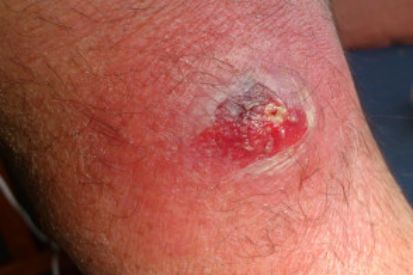Abscess-Boil
Our experienced dermatologists offer comprehensive services, from accurate diagnosis through physical examinations to personalized treatment plans. We focus on relieving pain and promoting healing, often incorporating drainage techniques like incision and drainage (I&D).
Through prescription medications and preventive measures, we aim to not only address the immediate concern but also reduce the risk of recurrence. Trust us for expert care, education on skincare practices, and ongoing support for your skin health journey.
Examples of Abccess-Boil





Symptoms of Abscesses and Boils
- Boils manifest as red, tender, and painful lumps on the skin, typically filled with pus.
- The affected area may be swollen and warm to the touch.
- Boils contain a center filled with pus, which may require medical intervention
- The surrounding skin is often red and inflamed.
- In some cases, individuals may experience a fever, especially if the infection is severe.
- Boils and abscesses can be sensitive to the touch.
Causes of Abscesses and Boils
- Boils and abscesses can form as a result of a cut or break in the skin, which leads to a bacterial infection.
- Some boils are caused by an ingrown hair.
- Others are caused by plugged-up sweat glands, such as some types of cystic acne.
- They grow quickly and are usually painful until they drain.
- People with weakened immune systems are more susceptible to boils than the general population.
How to Prevent Abscesses and Boils
FAQs for Abscesses and Boils
While both involve a collection of pus, a boil specifically refers to a skin infection around a hair follicle. An abscess, on the other hand, can form in various body tissues, including organs and deeper layers of the skin.
Abscesses and boils often present as swollen, red, and painful lumps on the skin. They may be warm to the touch and can develop a white or yellow center (pus-filled head) as they progress.
Treatment may involve draining the abscess by making an incision, which can provide relief and promote healing. Antibiotics may also be prescribed to address the underlying infection. In some cases, more extensive surgical drainage may be necessary.
Over-the-counter creams may not be effective in treating abscesses or boils. While antibiotics can help with bacterial infections, they are typically prescribed by a healthcare professional after a proper evaluation. It's important to consult with a doctor before using any medications to ensure appropriate treatment.
Yes, abscesses and boils can be painful due to inflammation and the buildup of pressure. Over-the-counter pain relievers, such as acetaminophen or ibuprofen, may help alleviate pain. However, it's essential to consult with a healthcare professional for proper guidance on pain management and to address the underlying cause of the abscess or boil
From our QualDerm Family of Brands: Break Free From Your Skin Struggles
Treatments for Abscesses and Boils
Featured Blogs

- General Dermatology
- Skin Care
- Chronic Skin Conditions
Hormonal acne can be a pesky skin problem for many. The only way to address this is by finding a hormonal acne treatment that works for you and your unique skin.
Read More
- Skin Cancer
- General Dermatology
- Chronic Skin Conditions
Learn more about the most common types of skin lesions we see at Westerville Dermatology and how our dermatologists remove them.
Read More
- Skin Care
- Cosmetic Treatments
Unlock the secrets to achieving radiant, glowing skin. Explore expert tips and skincare routines tailored to nourish and revitalize your complexion, empowering you to embrace a luminous and youthful appearance.
Read MoreFeatured Products

DefenAge 2 Minute Reveal Masque
See amazing skin-brightening in minutes. A blend of ultrafine sugar crystals suspended in a gently warming creamy masque, it quickly uncovers the healthy skin beneath surface debris. When used once or twice a week, it helps the products that follow work on the upper skin layers more effectively. Adding water melts the crystals as you reveal new skin, and an instantly refreshed, younger-looking complexion. Free from microbeads and fragrance. 2.5 oz / 71 g

EltaMD UV Clear SPF 46
Oil-free EltaMD UV Clear helps calm and protect sensitive skin types prone to discoloration and breakouts associated to acne and rosacea. It contains niacinamide (vitamin B3), hyaluronic acid and lactic acid, ingredients that promote the appearance of healthy-looking skin. Very lightweight and silky, it may be worn with makeup or alone. Choose from tinted and untinted formulas for use every day. 1.7 oz / 48 g
